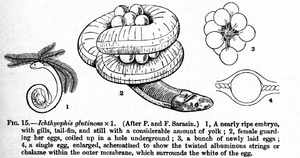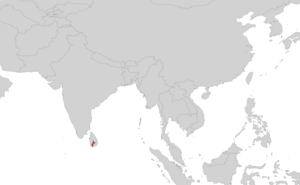Ceylon caecilian facts for kids
Quick facts for kids Ceylon caecilian |
|
|---|---|
 |
|
| Conservation status | |
| Scientific classification | |
| Genus: |
Ichthyophis
|
| Species: |
glutinosus
|
 |
|
| Ichthyophis glutinosus range | |
The Ichthyophis glutinosus, also known as the Ceylon caecilian or common yellow-banded caecilian, is a unique animal. It is a type of caecilian, which is an amphibian. Caecilians look a lot like worms or snakes. This specific caecilian is found only in Sri Lanka. It lives in wet, warm forests and grassy areas.
What Does It Look Like?
The Ceylon caecilian can grow to be about 23 to 40 centimeters long. It looks a lot like a big earthworm! Its skin has over 300 rings, or 'folds,' all around its body. These folds make it look like it's made of many small segments.
It has a round snout on its head. Near its mouth, it has two special feelers called 'tentacles.' These tentacles can stretch out and help the caecilian sense its surroundings, like smell or touch. They are closer to its eyes than to its nose.
This caecilian is usually a shiny blue-gray on top. Its belly is a light yellow. It also has a bright yellow stripe running down each side of its body.
Where Does It Live?
This special amphibian lives only in Sri Lanka. You can find it in the southwestern and central parts of the island.
The Ceylon caecilian lives underground in burrows. It likes damp soil or piles of dead leaves. Its favorite places are moist tropical forests, swampy areas, and even some cleared forest lands. You can find it from sea level up to about 1,355 meters high in the mountains.
How Does It Live?
The Ceylon caecilian eats earthworms and other small creatures without backbones. When it catches an earthworm, it pulls it back into its burrow. Sometimes, it twists its head or whole body to make sure its prey can't get away.
Reproduction happens in hidden spots underground. The female caecilian lays about 30 white eggs. These eggs are covered in a jelly-like substance. The mother then wraps her body around the eggs. She stays with them and protects them until they hatch.
When the eggs hatch, tiny larvae come out. They are about 7 to 11 centimeters long. These larvae leave the burrow and wiggle their way to pools or streams. These water bodies form during the wet season.
Young caecilian larvae have three pairs of feathery gills on the outside of their bodies. They also have a special 'lateral line' system. This system helps them sense movement in the water. They have a tail fin too, which helps them swim. As they grow, they lose their lateral line system. Their gills stay for a while. They slowly change into adult caecilians. This change, called metamorphosis, takes about nine months.
Is It Safe?
The IUCN Red List of Threatened Species says the Ceylon caecilian is "vulnerable." This means it could be at risk in the future. Its home range is smaller than 20,000 square kilometers.
However, in the places where it lives, it is quite common. It also seems to be good at adapting to changes in its habitat. This means it can live in different kinds of environments. Many areas where it lives are protected national parks. These include the Sinharaja Forest Reserve, the Knuckles Mountain Range, the Dellawa Forest Reserve, and the Udawatta Kele Sanctuary. These protected areas help keep the Ceylon caecilian safe.


